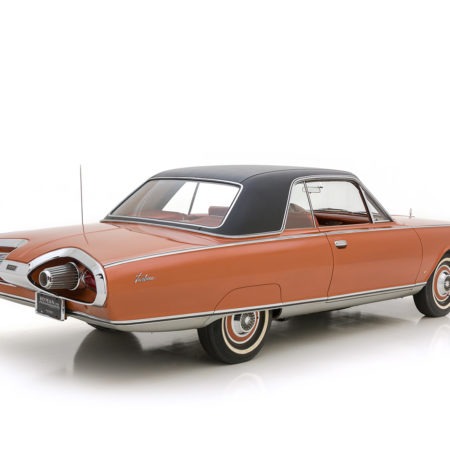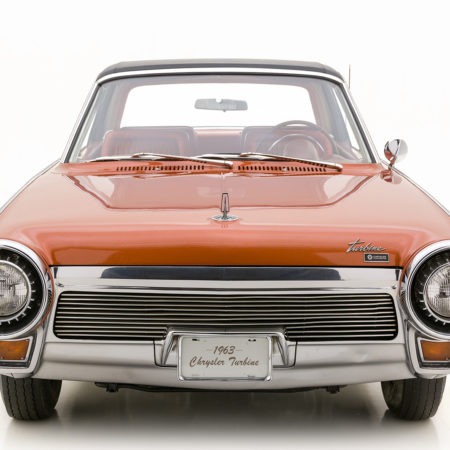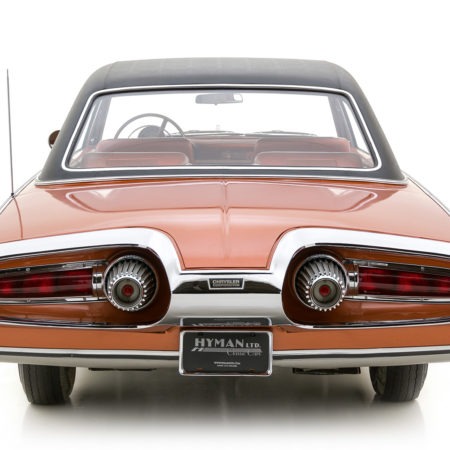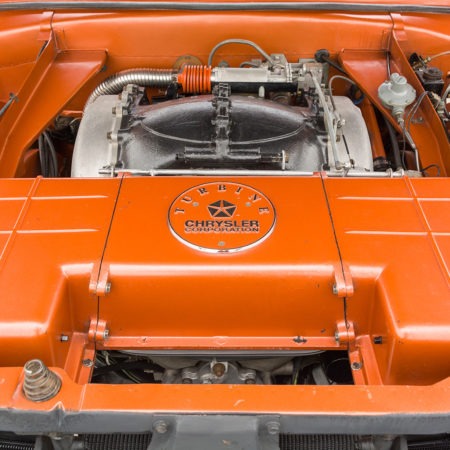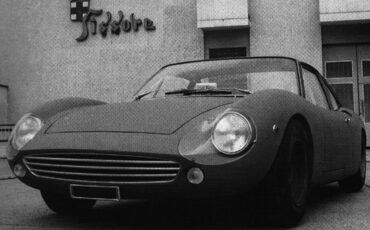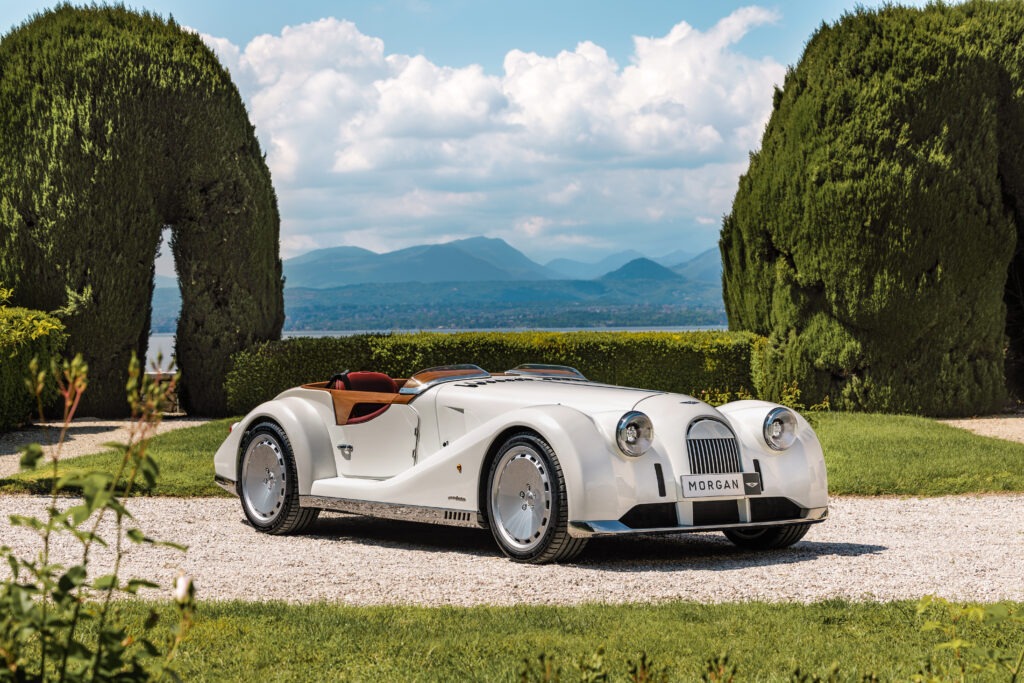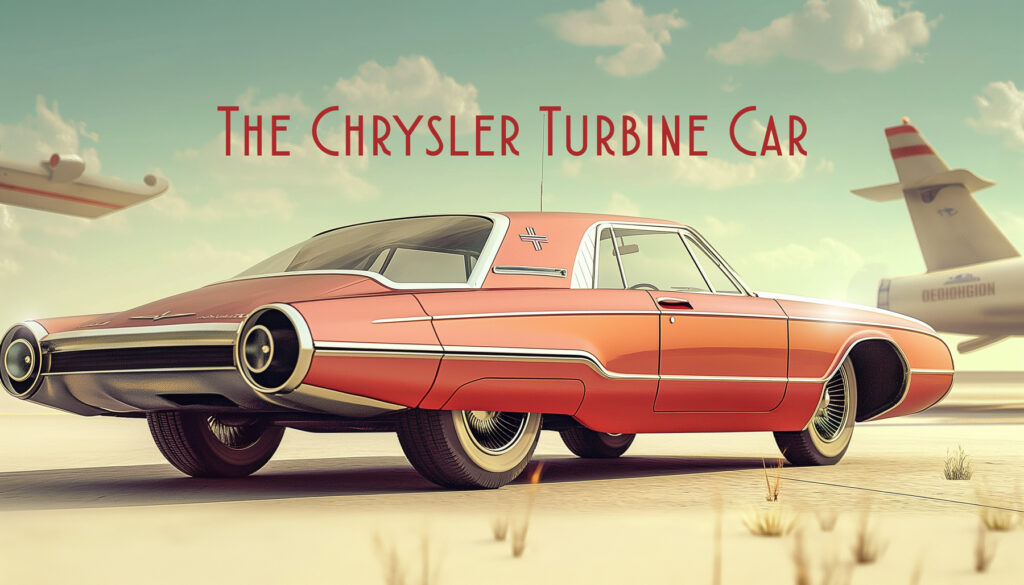
The pursuit of a gas turbine engine for automotive use in the United States can be traced back to the early 1900s when Dr. Sanford Moss of General Electric embarked on pioneering efforts. These early attempts, however, were overshadowed by the inefficiency of the technology compared to the rising popularity of steam turbines. It wasn’t until 1935 that a significant development took place during a demonstration at Chrysler, where Dr. Moss showcased a turbo supercharger on a Chrysler Imperial. This encounter led George Huebner, a key figure at Chrysler, to delve into gas turbine research.
Amid the progress in aeronautics during World War II, Dr. Moss and Mr. Huebner collaborated on a fighter plane engine project, the X1 2220. This liquid-cooled piston engine, featuring an inverted V-16 design, incorporated a gas turbine powered by the hot exhaust gas. Unfortunately, the war concluded before the engine could reach production, putting a temporary halt to gas turbine research at Chrysler.
Post-war, the focus shifted back to gas turbine engines for passenger cars. In 1946, the U.S. Navy’s Bureau of Aeronautics awarded Chrysler a contract for a 1000 H.P. prop jet engine, known as the A-86. This project, culminating in 1949, marked a pivotal moment, steering Chrysler’s attention back to the automotive gas turbine engine. The A-86 utilized a fixed heat exchanger called a recuperator, which was later deemed unsuitable for automotive use due to its size.
A breakthrough came in 1951 when Mr. Huebner and his team embraced the challenge of developing a gas turbine engine for passenger cars without the conventional recuperator. Contemporary efforts to implement a regenerator, a rotating heat exchanger, had faced numerous setbacks, with experts cautioning against its use due to manufacturing challenges, leakage concerns, and power loss. Undeterred, Mr. Huebner and his team pressed on, determined to make the regenerator work. This marked a turning point, proving that practical gas turbine engines for automotive applications were not only possible but on the horizon.
The regenerator, implemented in 1951, became a crucial component in enhancing fuel economy. By preheating incoming air and cooling exhaust gases leaving the engine, the regenerator effectively recycled waste heat, contributing to the efficiency of the gas turbine engine. With this breakthrough, Chrysler realized that the dream of a practical gas turbine-powered automobile was within reach.
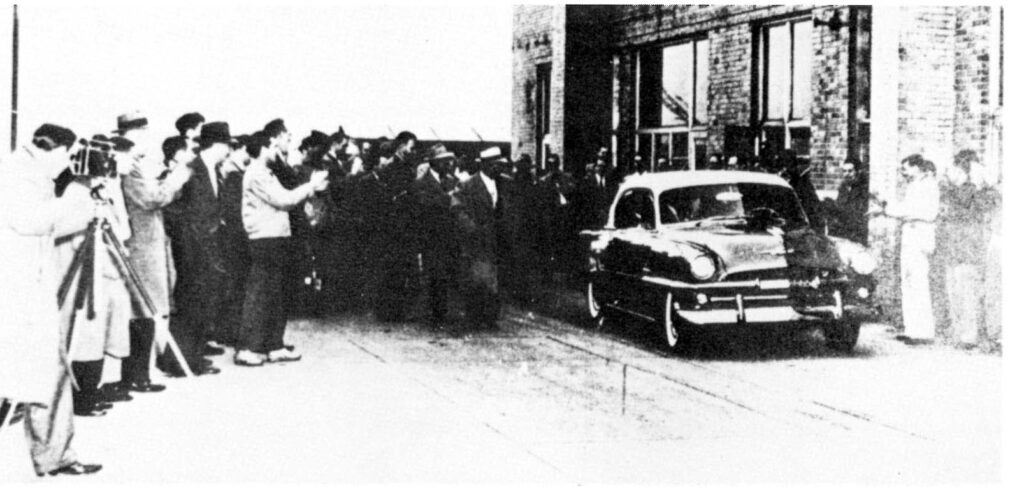
The stage was set for the next chapter in the history of the Chrysler Turbine Car, as the company transitioned from theoretical breakthroughs to the practical application of gas turbine technology in passenger vehicles.
The First Generation Unveiled
In 1953, the automotive world witnessed a groundbreaking moment as the first turbine-powered passenger car came to life. A 1954 Plymouth Belvedere Sport Coupe, under the visionary guidance of George Huebner, marked the commencement of an era that would revolutionize the automotive landscape. Mr. Huebner vividly recalls the historic first ride: “The car was moving under its own power. I was driving it, and Sam Williams was sitting next to me. Dave Borden was in the back seat. Word had gotten out that we were going to try a turbine car for the first time. We started it, and started to move out, and the cheers started. It was quite an exciting event. There must have been three hundred people hanging out of windows and leaning over the roof. With the cheers and the applause, I suppose the rest of the place must have wondered what in the hell was going on over there. Word got around pretty fast. That was the fall of 1953.”
The public debut of the turbine car occurred in 1954 at the then brand-new, undedicated proving grounds. Later that year, during the dedication of the proving grounds, two 1954 Plymouth turbine cars were showcased. A memorable demonstration ensued when K.T. Keller balanced a nickel on edge on the running engine, highlighting the smoothness of the turbine. Subsequently, in 1955, the first-generation engine found its way into a Plymouth, although this particular car never made a public appearance. Instead, it served as a testbed for driving evaluations on the streets of Detroit.
The momentum of development propelled the turbine car into a cross-country journey in 1956. On March 26th of that year, a standard production Plymouth sedan departed from the Chrysler Building in New York City and, four days and 3,020 miles later, arrived at the Los Angeles City Hall. This milestone journey showcased the turbine car’s potential, achieving 13 MPG using unleaded gas and some diesel fuel. Despite encountering challenges, such as the failure of an intake casting and reduction gear bearing, the engine and its components proved to be robust and reliable.
However, a notable drawback emerged during this first generation – an acceleration lag of approximately seven to eight seconds, making driving in heavy traffic impractical. The need for improvement paved the way for the second generation engine, a larger powerhouse designed for 250 horsepower, a significant upgrade from the 90-100 HP of its predecessor.
The acceleration lag was reduced to approximately 3 to 3.5 seconds, though challenges remained, especially when turning corners. The introduction of variable nozzle vanes, manually adjustable under the hood, brought significant improvements, particularly in engine braking. Fuel economy also saw an increase, reaching 16 MPG. Advancements in compressor and regenerator efficiency further optimized performance.
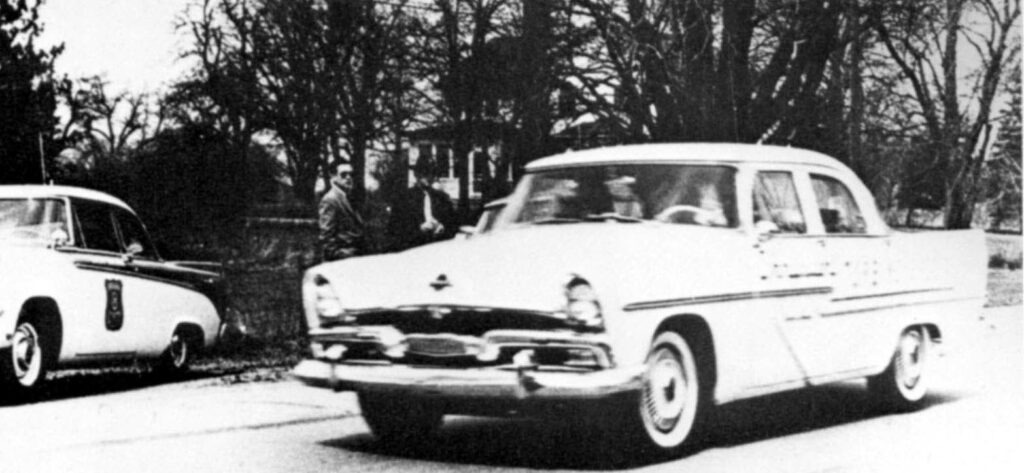
Crucially, the second generation marked a milestone in metallurgy. Chrysler’s metallurgical research yielded high-temperature alloys composed of abundant and cost-effective elements, such as iron and aluminum. These alloys found application in combustion chamber liners, turbine wheels, and blades, overcoming the limitations posed by rare and exotic metals used in aircraft engines. The first generation had laid the foundation, and the second generation was poised to push the boundaries of turbine car technology even further.
The Evolution: Second Generation
The evolution of the Chrysler Turbine Car continued with the introduction of the second generation engine, a groundbreaking leap forward in automotive innovation. In 1959, this powerful engine found its home in a 1959 Plymouth four-door hardtop, setting the stage for a new era of turbine-powered vehicles.
The Turbine Special, featuring the second generation engine, embarked on a 576-mile test run from Detroit to New York City in December of 1958. This journey not only showcased the capabilities of the turbine technology but also yielded significant gains in fuel economy, a crucial factor in the ongoing development of these futuristic vehicles.
Building on the successes of the second generation, a third generation engine was conceptualized, designed, and developed. This new engine, known as the CR 2A, incorporated the variable nozzle concept introduced in the second generation but took it a step further. Now a fully automatic continuously variable system, the CR 2A brought about improvements in engine braking, enhanced fuel consumption, and a gas generator lag reduced to just slightly over two seconds.
In the spring of 1961, the public witnessed the unveiling of a trio of vehicles featuring the third generation engine. The experimental sports car, named Turboflite, was a testament to the versatility of the turbine technology. Built in Italy by Carrozzeria Ghia and designed by Virgil Exner, it not only boasted the powerful turbine under the hood but also showcased advanced styling elements. Retractable headlights, a deceleration air flap suspended between stabilizing struts, and an automatic canopied roof added to the allure of this remarkable vehicle. Displayed at major auto shows around the world, the Turboflite turned heads and captured imaginations.
The second member of the trio was a 1960 Plymouth four-door hardtop, essentially a standard production unit with the exception of the revolutionary engine and some minor trim changes. The final member of the trio was a Dodge 2½ ton truck, emphasizing the adaptability of the turbine for diverse automotive applications. Though the engine in the truck was fundamentally the same as the passenger car unit, its installation underscored the potential of the turbine in a range of vehicle types.
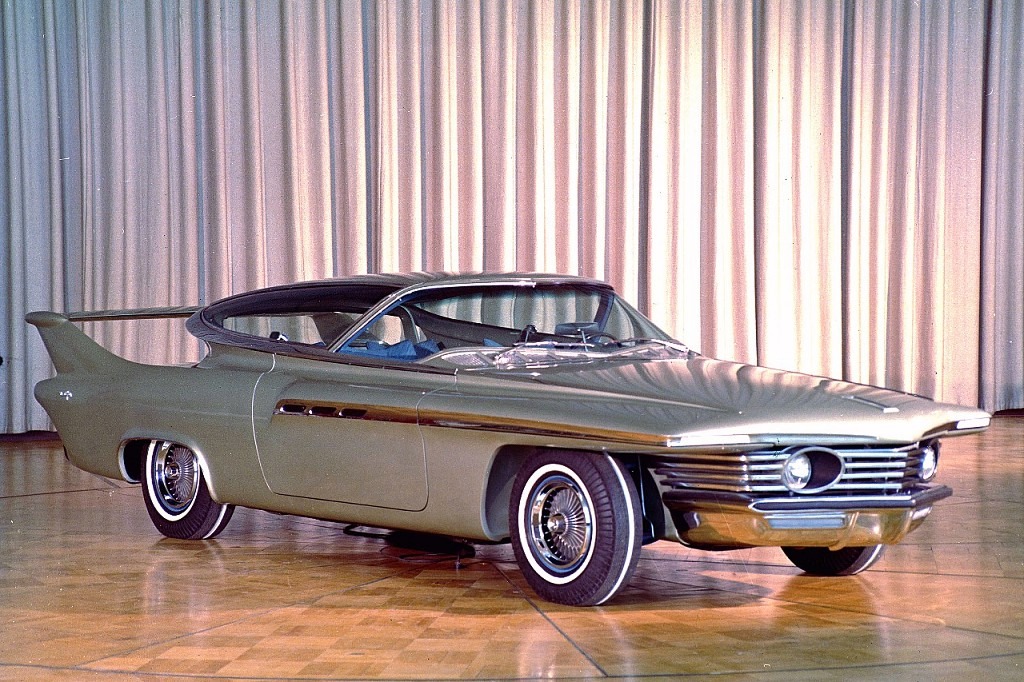
Despite the strides in turbine car development, the early 1960s presented challenges for Chrysler. Rumors circulated about financial troubles and the possible demise of the corporation. However, these claims were unfounded, as Chrysler never approached a state of bankruptcy. The main challenges were dwindling product and dealer morale, with sales reaching abysmal levels.
In response to this uncertain climate, a strategic decision was made to construct a number of turbine cars for display at local dealerships across the United States. The aim was to bolster confidence in the future of the corporation and improve showroom traffic. These turbine cars, a tangible symbol of Chrysler’s commitment to innovation, became a beacon of hope during challenging times and laid the groundwork for the continued evolution of turbine-powered vehicles.
The Triumph of the Third Generation
The third generation of the Turbine Car ushered in a new era of innovation and resilience, showcasing the turbine’s adaptability and reliability in the face of adverse conditions. In a modified 1962 Dodge, the third generation engine made its mark, with styling modifications that included a distinctive bladed wheel motif in the grille and wheel covers. These modifications were not merely aesthetic; they were crucial to supply the turbine with the copious amounts of air it required to operate efficiently.
A defining moment for the third generation came during a coast-to-coast run in the winter of 1961-1962. Departing from New York City on December 27, 1961, the Turbo Dart traveled 3,100 miles through treacherous snowstorms, freezing rain, sub-zero temperatures, and relentless headwinds. Despite the challenging conditions, the turbine’s suitability for automotive use was vividly demonstrated. It exhibited better fuel economy and easier cold weather starting compared to the piston-engined support vehicle accompanying the Turbo Dart.
The success of this program prompted the construction of the Turbo Fury, another vehicle equipped with the CR 2A engine and similar styling modifications to the Turbo Dart. This dynamic duo embarked on a nationwide tour, engaging in displays and consumer evaluations. The Turbo cars, when on display in crowded dealer showrooms with engines running, not only captivated audiences with their futuristic appeal but also highlighted an essential side benefit – extremely low exhaust emissions.
Impressed by the positive response and the environmental benefits, the decision was made to produce turbine-powered cars for the public. On February 14, 1962, Chrysler made a historic announcement, revealing plans to build approximately fifty turbine-powered passenger cars for selected users by the end of 1963. The commitment to mass-producing turbine-powered automobiles was further underscored at the Chicago Auto Show from February 17 to 25, 1962, where Chrysler showcased three vehicles: the Turbo Dart, Turbo Fury, and a new Dodge Turbo Truck.
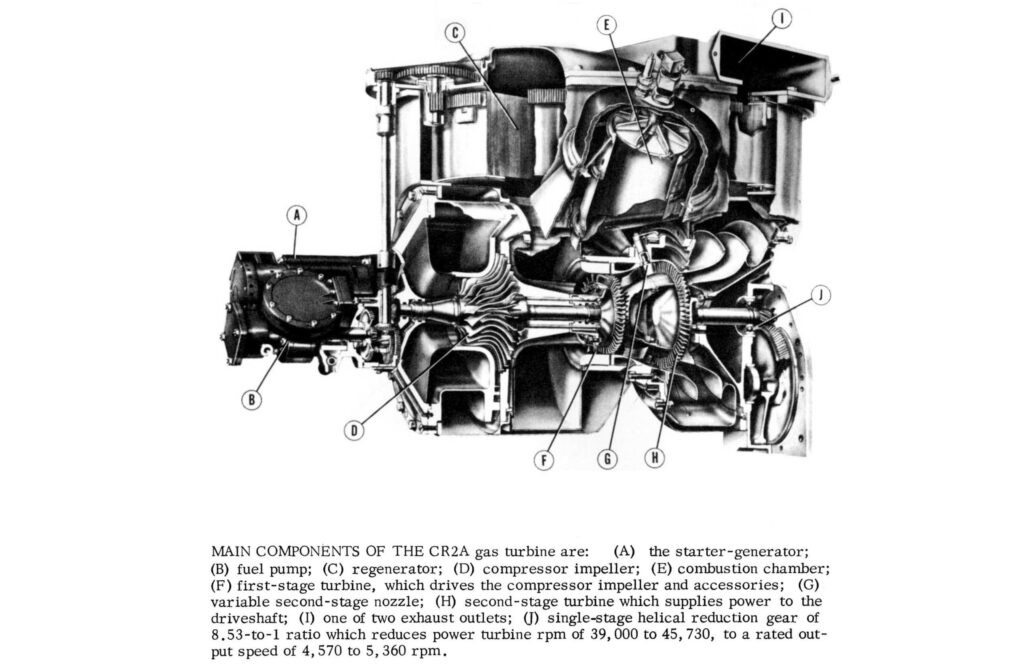
The recognition of the groundbreaking work came in the form of an award from the Power Division of the American Society of Mechanical Engineers. On March 7, 1962, George J. Huebner Jr., Executive Engineer of Research for Chrysler Corporation, received this prestigious award for his leadership in developing the first automotive gas turbine suitable for mass-produced passenger automobiles. This marked a significant milestone, not only for Chrysler but for the automotive industry as a whole, as it recognized the revolutionary impact of the turbine technology on mainstream transportation.
The Chrysler Turbine Car Takes Center Stage
On May 14, 1963, the automotive world witnessed a momentous occasion – the grand unveiling of the Chrysler Turbine Car at the Essex House in New York City. This marked the official launch of a groundbreaking program aiming to construct fifty turbine-powered automobiles and place them in the hands of selected drivers for comprehensive evaluation in real-world, everyday use. Unlike its predecessors, the Turbine Car was not conceived as a futuristic dream car; instead, it embodied a contemporary vehicle with distinctive styling tailored to its role as a vessel for the revolutionary turbine engine.
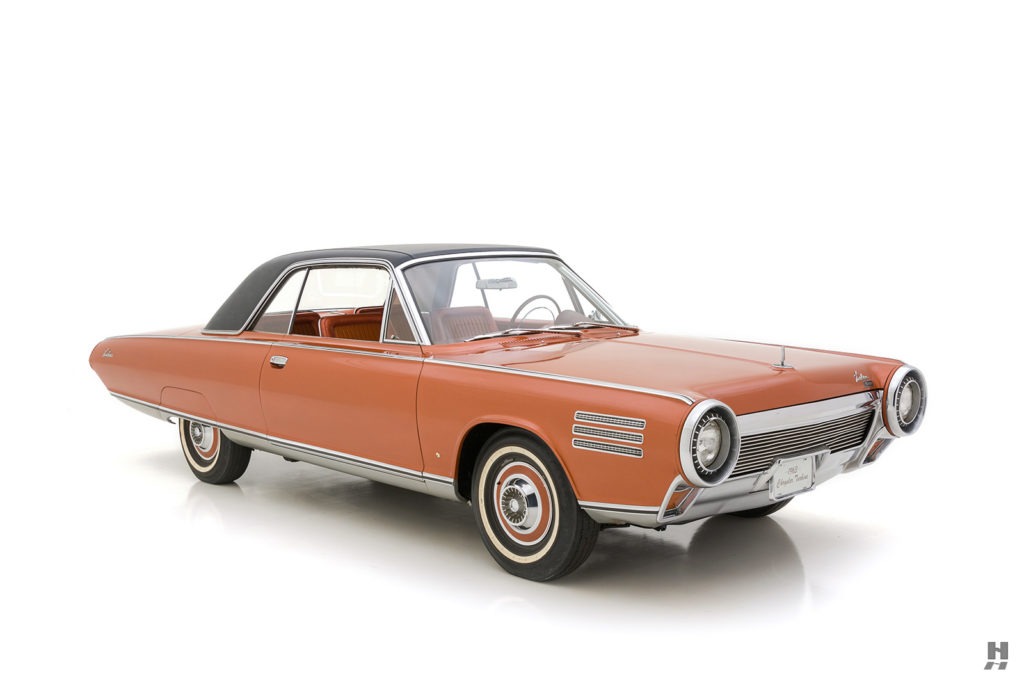
Under the hood, the turbine engine stood out against the sheet metal, showcasing a meticulous combination of bright metal and paint. The engine housing, in Turbine Bronze, featured polished aluminum end covers and exhaust collectors, creating a visual spectacle. A circular plaque on the inlet duct proudly displayed the Pentastar and the words “Chrysler Corporation Turbine,” underscoring the innovative power beneath.
Unique chassis features distinguished the Turbine Car, including a rubber-insulated unit front suspension that allowed the engine, transmission, and suspension to be removed as a single unit. The relay-link steering system enabled a low steering column angle, and distinct rear shock absorber mounts accommodated the twin exhaust ducts. Notably, the front suspension was isolated, a first at Chrysler and an industry first, addressing the challenge of road harshness and noise transmitted to the interior in the absence of a piston engine’s vibrations.
Before settling on the final design, considerations were given to producing the car as a two-passenger mid-engine roadster, initially named Typhoon alongside the four-passenger car. Ultimately, both configurations were unified under the name Turbine Car.
Five engineering prototypes, including four in the Turbine Bronze color scheme and one pearlescent white, were developed. The fifth car featured the fourth generation engine, a more advanced design with dual regenerators and a centrally located burner. This new configuration improved responsiveness, reduced weight, enhanced compactness, and minimized noise. Operating on any fuel that would burn with air, including unconventional options like tequila in Mexico, the turbine engines showcased their adaptability.
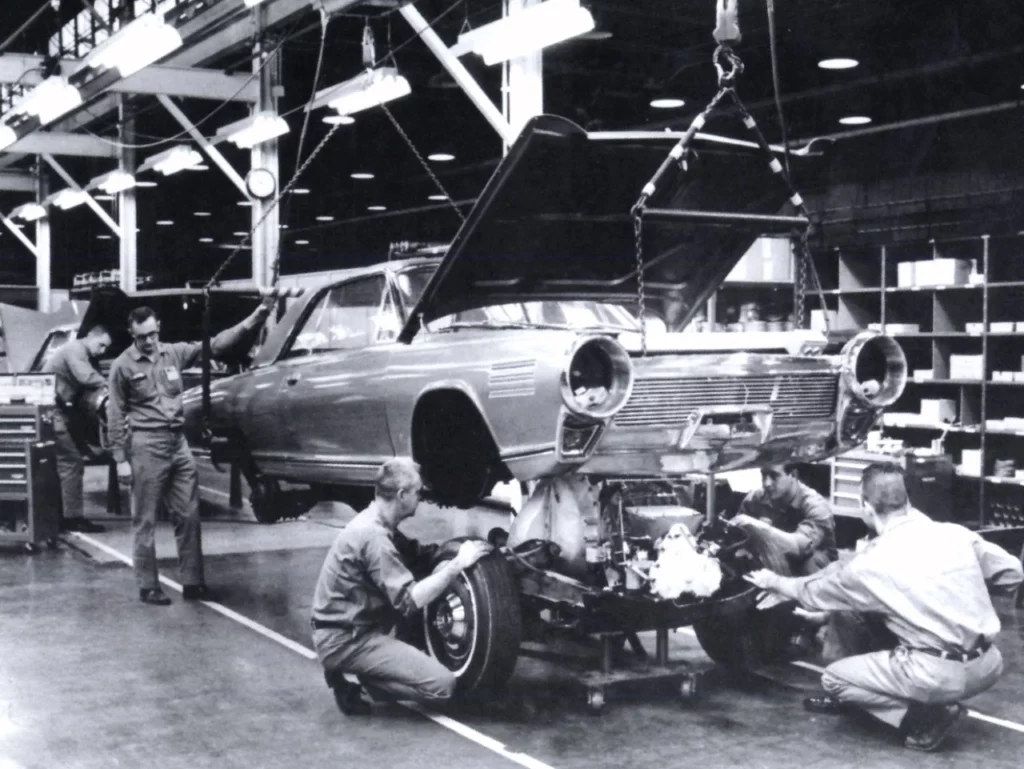
Production of the Turbine Cars commenced at a rate of one per week, with the final car completed in October 1964. The special assembly line, located at Chrysler’s Engineering Research Laboratories in Detroit, saw the marriage of the Chrysler-designed body and Ghia-built body to the innovative engine and chassis components. The production process culminated in the creation of a unique fleet of turbine-powered vehicles poised for real-world testing.
The objectives of the program were ambitious – to assess consumer and market reactions to the turbine technology, gather service data, and compile driver experiences under diverse conditions. Each user entered into a no-charge agreement with Chrysler, receiving a vehicle, license, insurance, and service for a three-month evaluation period. Fuel was the only responsibility shouldered by the users.
The turbine program, involved 203 motorists, each contributing to a collective mileage ranging from 1,149 miles to an impressive 14,046 miles. The deliveries commenced on October 29, 1963, and concluded on January 28, 1966. The Chrysler Turbine Car had transitioned from an experimental prototype to a tangible reality, leaving an indelible mark on automotive history as a symbol of innovation, adaptability, and the tireless pursuit of progress.
Design and Carrozzeria Ghia Involvement
The iconic design of the Chrysler Turbine Car was the product of collaboration between Chrysler’s design studios and the renowned Italian coachbuilder Carrozzeria Ghia. Under the direction of Elwood Engel, formerly of Ford Motor Company, the design team aimed to create a vehicle that not only showcased innovative turbine technology but also competed with established sports cars like the Chevrolet Corvette and Ford Thunderbird.
Referred to by some as the “Englebird” due to its resemblance to Engel’s previous work on the Thunderbird, the Turbine Car boasted a sleek and aerodynamic profile, with distinctive styling elements that set it apart from conventional automobiles of the era. Its striking exterior, featuring deeply-recessed headlights, chrome bezels, and a metallic “turbine bronze” paint finish, exuded a sense of futuristic elegance.
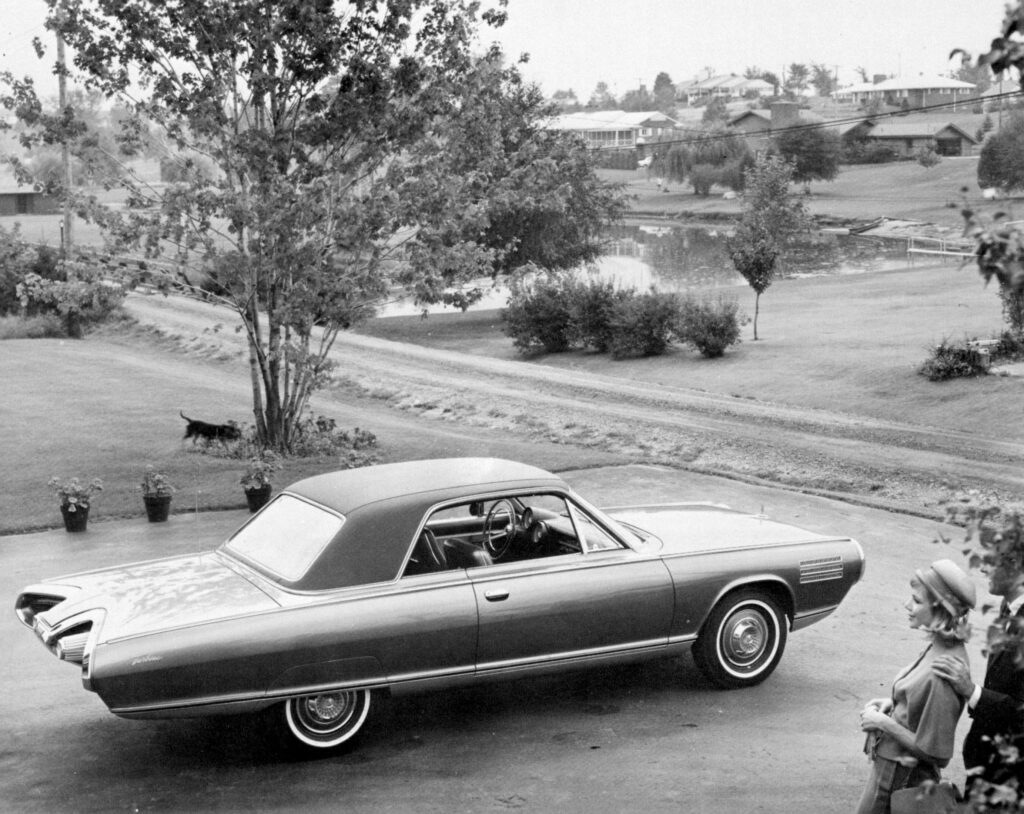
Carrozzeria Ghia, renowned for its expertise in crafting bespoke automotive bodies, was tasked with handcrafting the Turbine Car’s bodies. Each body was meticulously assembled, painted, trimmed, and upholstered in Italy before being shipped to Chrysler’s facility in Detroit for final assembly. The collaboration between Chrysler and Ghia resulted in a seamless integration of Italian craftsmanship and American engineering, culminating in a masterpiece of automotive design. Despite its stunning appearance, the Turbine Car faced early challenges during the prototype phase, including sluggish acceleration and vibration issues attributed to tire treads. These challenges were addressed through meticulous troubleshooting and refinement, ensuring that the production models delivered optimal performance and comfort.
A total of 50 identical Turbine Cars were produced between 1963 and 1964, all featuring a two-door hardtop coupe configuration with air-over-oil power brakes and power steering. The interior, characterized by bronze-colored leather upholstery, deep-pile carpeting, and brushed aluminum accents, exuded luxury and sophistication. Noteworthy features included leather-upholstered bucket seats, whitewall tires, and a dashboard adorned with large gauges monitoring essential engine parameters.
Failure and Legacy
The 1963 Chrysler Turbine Car, having successfully completed its rigorous user evaluation program, emerged from the confines of mere automotive experimentation to become a beacon of innovation that transcended traditional boundaries. It embarked on a journey that took it far beyond the controlled environments of testing grounds and exhibitions, venturing into the realms of U.S. shopping centers, international tours, and even gracing the illustrious stage of the 1964 New York World’s Fair.
The post-evaluation chapter in the Turbine Car’s story was marked by a captivating tour of U.S. college campuses, turning these experimental vehicles into not just symbols of cutting-edge technology but also ambassadors of forward-thinking design. The turbine cars became more than metallic prototypes; they became messengers of a future where automotive possibilities knew no bounds.
As these turbine cars made their appearances at shopping centers and took part in a Chrysler International World Tour, they showcased a commitment to pushing the boundaries of automotive technology. The public’s fascination with these marvels on wheels grew, transforming them into global icons of progress and modernity.
The Chrysler Turbine Car’s legacy is deeply intertwined with its public persona as an ambassador of innovation. Beyond the laboratory and the test track, these vehicles became cultural touchstones, representing the spirit of exploration and experimentation that defined an era.
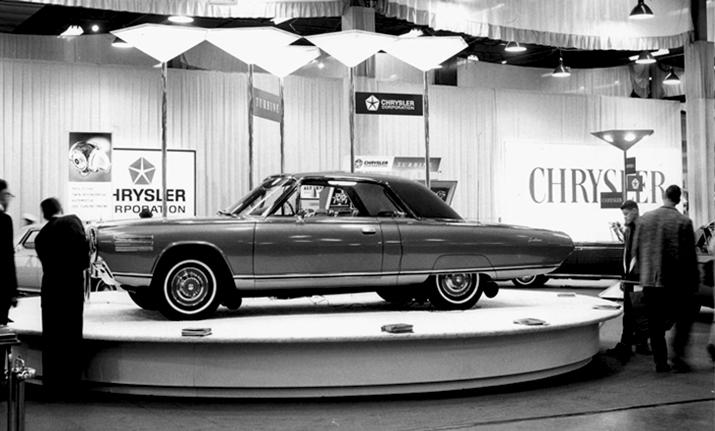
The turbine cars, having captured the imagination of audiences worldwide, found their place in the ongoing narrative of automotive progress. Their appearances at international events and college campuses underscored not only their technological prowess but also their cultural significance. The Chrysler Turbine Car was no longer just an experiment; it was a symbol of what the automotive future could hold.
However, the journey of the Turbine Car extended beyond public appearances. The subsequent chapters in its story delve into the challenges faced by Chrysler as they navigated emission standards, sought technological advancements, and grappled with the complexities of bringing a groundbreaking technology to fruition.
In the course of evaluating the fifty turbine cars, the role of the Environmental Protection Agency (EPA) added a crucial layer to the narrative. The request for emission testing opened a new chapter, steering Chrysler towards addressing not only the technological marvel of the turbine engine but also the environmental concerns that would shape the future of the automotive industry.
The development of the sixth-generation turbine engine showcased Chrysler’s unwavering determination to overcome hurdles. As the automotive landscape shifted with regulatory demands, Chrysler’s commitment to innovation became even more pronounced. The partnership with the EPA marked a significant milestone, aligning the turbine technology with stringent emissions standards and reinforcing its potential to be a sustainable option for the future.
Yet, the path to success was fraught with challenges. The temporary halt in 1969 reflected the intricate dance between innovation and practicality, acknowledging the delicate balance required in navigating the complexities of automotive development. Despite setbacks, Chrysler’s perseverance led to the creation of the seventh-generation engine, introducing groundbreaking features that pushed the boundaries of what a turbine engine could achieve.
The fate of the 50 test cars, with 46 deliberately dismantled, adds a layer of intrigue to the narrative. Whether driven by tariff considerations, public relations strategies, or a desire to retain control over experimental technology, the decision aligned with industry norms, yet sparked debates about the preservation of automotive history.
The surviving examples of the Chrysler Turbine Car ensure that its legacy endures. These remarkable vehicles, with three retained by Chrysler and two still owned by the company, represent not just technological marvels but also the indomitable spirit of innovation. The display of six cars in prestigious museums across the United States contributes to the preservation of their unique history, allowing future generations to witness the tangible impact of automotive ingenuity.
The private ownership of two operational cars, including one by comedian and TV host Jay Leno, adds a personal touch to the legacy. These cars, fully operational and in private collections, serve as living testaments to the enduring fascination and significance of the Chrysler Turbine Car in the landscape of automotive innovation.
As the automotive industry continues to explore alternative propulsion technologies and grapple with emissions challenges, the legacy of the Turbine Car serves as a guiding force. It resonates as a reminder of the pioneering spirit that propels the quest for cleaner, more efficient engines. The echoes of the Turbine Car’s impact reverberate in ongoing efforts to redefine the future of transportation, making it not just a relic of the past but a beacon illuminating the road ahead. The Chrysler Turbine Car, once a symbol of experimentation, has become an enduring testament to the unyielding pursuit of progress in the automotive world.

